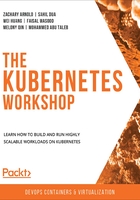
Introduction
We ended the previous chapter by providing a brief and abstract introduction to Kubernetes, as well as some of its advantages. In this chapter, we will provide you with a much more concrete high-level understanding of how Kubernetes works. First, we will walk you through how to install Minikube, which is a handy tool that creates a single-node cluster and provides a convenient learning environment for Kubernetes. Then, we will take a 10,000-foot overview of all the components, including their responsibilities and how they interact with each other. After that, we will migrate the Docker application that we built in the previous chapter to Kubernetes and illustrate how it can enjoy the benefits afforded by Kubernetes, such as creating multiple replicas, and version updates. Finally, we will explain how the application responds to external and internal traffic.
Having an overview of Kubernetes is important before we pe deeper into the different aspects of it so that when we learn more specifics about the different aspects, you will have an idea of where they fit in the big picture. Also, when we go even further and explore how to use Kubernetes to deploy applications in a production environment, you will have an idea of how everything is taken care of in the background. This will also help you with optimization and troubleshooting.